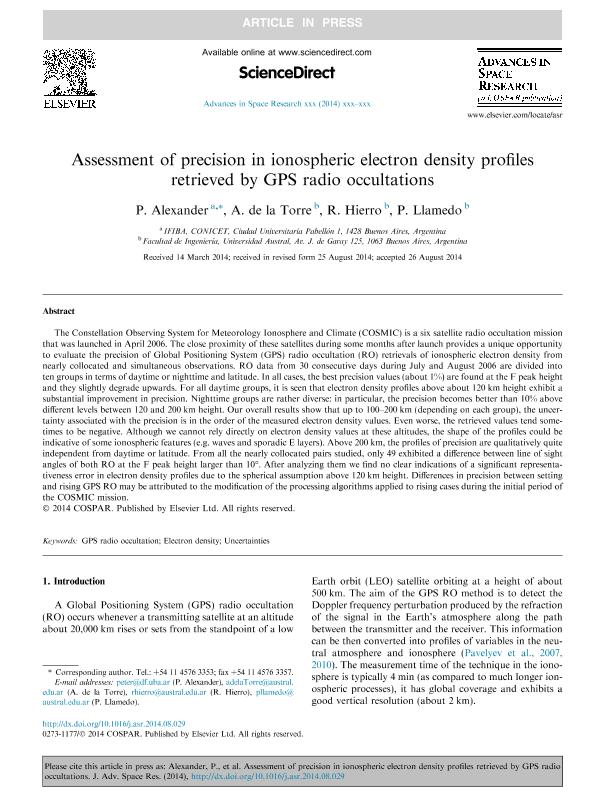Mostrar el registro sencillo del ítem
dc.contributor.author
Alexander, Pedro Manfredo

dc.contributor.author
de la Torre, Alejandro

dc.contributor.author
Hierro, Rodrigo Federico

dc.contributor.author
Llamedo Soria, Pablo Martin

dc.date.available
2017-06-26T19:17:58Z
dc.date.issued
2014-12
dc.identifier.citation
Alexander, Pedro Manfredo; de la Torre, Alejandro; Hierro, Rodrigo Federico; Llamedo Soria, Pablo Martin; Assessment of precision in ionospheric electron density profiles retrieved by GPS radio occultations; Elsevier; Advances in Space Research; 54; 11; 12-2014; 2249-2258
dc.identifier.issn
0273-1177
dc.identifier.uri
http://hdl.handle.net/11336/18894
dc.description.abstract
The Constellation Observing System for Meteorology Ionosphere and Climate (COSMIC) is a six satellite radio occultation mission that was launched in April 2006. The close proximity of these satellites during some months after launch provides a unique opportunity to evaluate the precision of Global Positioning System (GPS) radio occultation (RO) retrievals of ionospheric electron density from nearly collocated and simultaneous observations. RO data from 30 consecutive days during July and August 2006 are divided into ten groups in terms of daytime or nighttime and latitude. In all cases, the best precision values (about 1%) are found at the F peak height and they slightly degrade upwards. For all daytime groups, it is seen that electron density profiles above about 120 km height exhibit a substantial improvement in precision. Nighttime groups are rather diverse: in particular, the precision becomes better than 10% above different levels between 120 and 200 km height. Our overall results show that up to 100?200 km (depending on each group), the uncertainty associated with the precision is in the order of the measured electron density values. Even worse, the retrieved values tend sometimes to be negative. Although we cannot rely directly on electron density values at these altitudes, the shape of the profiles could be indicative of some ionospheric features (e.g. waves and sporadic E layers). Above 200 km, the profiles of precision are qualitatively quite independent from daytime or latitude. From all the nearly collocated pairs studied, only 49 exhibited a difference between line of sight angles of both RO at the F peak height larger than 10. After analyzing them we find no clear indications of a significant representativeness error in electron density profiles due to the spherical assumption above 120 km height. Differences in precision between setting and rising GPS RO may be attributed to the modification of the processing algorithms applied to rising cases during the initial period of the COSMIC mission.
dc.format
application/pdf
dc.language.iso
eng
dc.publisher
Elsevier

dc.rights
info:eu-repo/semantics/openAccess
dc.rights.uri
https://creativecommons.org/licenses/by-nc-sa/2.5/ar/
dc.subject
Gps Radio Occultation
dc.subject
Electron Density
dc.subject
Uncertainties
dc.subject.classification
Meteorología y Ciencias Atmosféricas

dc.subject.classification
Ciencias de la Tierra y relacionadas con el Medio Ambiente

dc.subject.classification
CIENCIAS NATURALES Y EXACTAS

dc.title
Assessment of precision in ionospheric electron density profiles retrieved by GPS radio occultations
dc.type
info:eu-repo/semantics/article
dc.type
info:ar-repo/semantics/artículo
dc.type
info:eu-repo/semantics/publishedVersion
dc.date.updated
2017-06-12T20:03:02Z
dc.journal.volume
54
dc.journal.number
11
dc.journal.pagination
2249-2258
dc.journal.pais
Países Bajos

dc.journal.ciudad
Amsterdam
dc.description.fil
Fil: Alexander, Pedro Manfredo. Consejo Nacional de Investigaciones Científicas y Técnicas. Oficina de Coordinación Administrativa Ciudad Universitaria. Instituto de Física de Buenos Aires. Universidad de Buenos Aires. Facultad de Ciencias Exactas y Naturales. Instituto de Física de Buenos Aires; Argentina
dc.description.fil
Fil: de la Torre, Alejandro. Universidad Austral; Argentina. Consejo Nacional de Investigaciones Científicas y Técnicas; Argentina
dc.description.fil
Fil: Hierro, Rodrigo Federico. Universidad Austral; Argentina. Consejo Nacional de Investigaciones Científicas y Técnicas; Argentina
dc.description.fil
Fil: Llamedo Soria, Pablo Martin. Universidad Austral; Argentina. Consejo Nacional de Investigaciones Científicas y Técnicas; Argentina
dc.journal.title
Advances in Space Research

dc.relation.alternativeid
info:eu-repo/semantics/altIdentifier/url/http://www.sciencedirect.com/science/article/pii/S0273117714005419
dc.relation.alternativeid
info:eu-repo/semantics/altIdentifier/doi/http://dx.doi.org/10.1016/j.asr.2014.08.029
Archivos asociados
